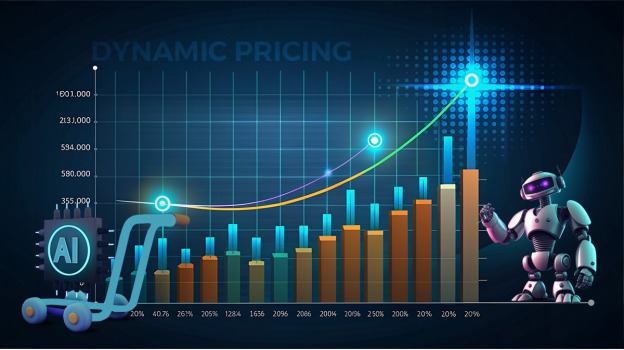In today’s rapidly evolving market, businesses must navigate complex pricing strategies and stay ahead of competitors to maintain a competitive edge. Artificial Intelligence (AI) is emerging as a game-changer in these areas, offering advanced solutions for dynamic pricing and competitive analysis. This guest post explores how AI-powered dynamic pricing solutions and AI-driven competitive analysis are revolutionizing industries, providing a comprehensive overview of their applications, benefits, and future prospects.
The Power of AI in Dynamic Pricing Solutions
Dynamic pricing is a strategy where prices are adjusted in real-time based on various factors such as demand, competition, and market conditions. AI-powered dynamic pricing solutions leverage machine learning algorithms to optimize pricing strategies and maximize revenue.
How AI-Powered Dynamic Pricing Works
1. Data Collection and Integration
AI-driven dynamic pricing systems begin by collecting vast amounts of data from various sources, including sales data, customer behavior, market trends, and competitor pricing. This data is integrated into a centralized system where it can be analyzed and processed.
2. Real-Time Analysis
Machine learning algorithms analyze the collected data in real-time to identify patterns and trends. These algorithms can process complex datasets quickly, providing insights into demand fluctuations, customer preferences, and market conditions.
3. Price Optimization
Based on the analysis, AI algorithms adjust prices dynamically to optimize revenue. The system considers factors such as supply and demand, competitor pricing, and customer willingness to pay. Price adjustments can occur at various intervals, including hourly, daily, or weekly, depending on the business model and market conditions.
4. Continuous Learning
AI-powered dynamic pricing solutions continuously learn and adapt based on new data and market changes. The algorithms improve their accuracy and effectiveness over time, ensuring that pricing strategies remain relevant and competitive.
Benefits of AI-Powered Dynamic Pricing
1. Increased Revenue
Dynamic pricing allows businesses to capture maximum value from their products and services. By adjusting prices based on real-time data, companies can increase revenue and improve profit margins.
2. Enhanced Competitiveness
AI-driven pricing strategies help businesses stay competitive by responding quickly to market changes and competitor actions. This agility ensures that companies can adapt their pricing to maintain a competitive edge.
3. Improved Customer Experience
Dynamic pricing can offer personalized pricing based on customer behavior and preferences. This personalization enhances the customer experience and can lead to higher satisfaction and loyalty.
4. Optimized Inventory Management
By aligning prices with demand, businesses can optimize inventory levels and reduce excess stock. This alignment helps in managing inventory more effectively and minimizing carrying costs.
Real-World Applications
1. E-Commerce
In e-commerce, dynamic pricing is used to adjust product prices based on demand, seasonality, and competitor pricing. Online retailers use AI algorithms to optimize pricing strategies and increase sales.
2. Travel and Hospitality
The travel and hospitality industries use dynamic pricing for airline tickets, hotel rooms, and rental cars. AI-powered systems adjust prices based on factors such as booking time, occupancy rates, and market demand.
3. Retail
Retailers employ dynamic pricing to adjust prices in response to changing market conditions and competitor actions. AI-driven pricing solutions help retailers remain competitive and drive sales.
AI for Competitive Analysis: Gaining the Edge
Competitive analysis is crucial for understanding market positioning and making informed strategic decisions. AI enhances competitive analysis by providing deeper insights and faster, more accurate assessments of competitors.
How AI Enhances Competitive Analysis
1. Data Aggregation
AI-powered competitive analysis tools aggregate data from various sources, including competitor websites, social media, financial reports, and market research. This data is consolidated into a unified platform for comprehensive analysis.
2. Sentiment Analysis
Natural Language Processing (NLP) algorithms analyze customer reviews, social media posts, and news articles to gauge sentiment toward competitors. This analysis provides insights into competitor strengths, weaknesses, and market perceptions.
3. Market Trend Identification
AI algorithms identify emerging market trends and patterns by analyzing vast datasets. These insights help businesses understand shifts in consumer behavior, industry developments, and competitive dynamics.
4. Competitive Benchmarking
AI tools benchmark competitors against various performance metrics, such as pricing, product features, and market share. This benchmarking helps businesses assess their position relative to competitors and identify areas for improvement.
5. Predictive Analytics
AI-driven predictive analytics forecast future competitive movements and market conditions. By analyzing historical data and trends, AI models predict competitor strategies, market shifts, and potential opportunities.
Benefits of AI in Competitive Analysis
1. Informed Decision-Making
AI provides actionable insights that inform strategic decision-making. By understanding competitor strategies and market trends, businesses can make data-driven decisions and develop effective strategies.
2. Faster Analysis
AI tools analyze large volumes of data quickly, providing real-time insights into competitor activities and market conditions. This speed enables businesses to respond promptly to changes and seize opportunities.
3. Enhanced Market Understanding
AI for competitive analysis enhances market understanding by identifying trends, customer preferences, and competitive dynamics. This understanding helps businesses adapt their strategies to meet market demands and outperform competitors.
4. Risk Mitigation
By monitoring competitor activities and market trends, AI helps businesses identify potential risks and challenges. This proactive approach allows companies to mitigate risks and develop contingency plans.
Real-World Applications
1. Market Research
AI-driven tools analyze market data, consumer behavior, and competitor strategies to provide insights for market research. Businesses use these insights to develop marketing strategies and identify growth opportunities.
2. Product Development
Competitive analysis informs product development by identifying gaps in the market and evaluating competitor offerings. AI tools help businesses understand market needs and develop innovative products.
3. Pricing Strategy
AI-powered competitive analysis helps businesses set competitive prices by analyzing competitor pricing strategies and market conditions. This analysis ensures that pricing aligns with market expectations and maximizes revenue.
Challenges and Considerations
1. Data Privacy and Security
AI-driven solutions rely on large volumes of data, raising concerns about data privacy and security. Businesses must ensure that data handling practices comply with regulations and protect sensitive information.
2. Integration with Existing Systems
Integrating AI tools with existing systems and workflows can be challenging. Organizations need to ensure compatibility and address potential integration issues to maximize the benefits of AI technologies.
3. Bias and Fairness
AI models can introduce biases based on the data they are trained on. It is essential to monitor and address potential biases to ensure fair and unbiased outcomes in pricing and competitive analysis.
4. Cost and Resource Investment
Implementing AI technologies requires significant investment in technology, infrastructure, and talent. Businesses must evaluate the costs and resources associated with AI adoption and ensure that the benefits justify the investments.
The Future of AI in Dynamic Pricing and Competitive Analysis
1. Advanced Algorithms
Future advancements in AI will lead to more sophisticated algorithms for dynamic pricing and competitive analysis. Enhanced algorithms will improve the accuracy and effectiveness of these solutions.
2. Greater Automation
AI will drive further automation in pricing and competitive analysis processes, handling increasingly complex tasks and optimizing workflows. This automation will enhance efficiency and reduce manual efforts.
3. Enhanced Personalization
AI will enable greater personalization in pricing and competitive strategies. Enhanced personalization will improve customer experiences and align strategies with individual preferences and behaviors.
4. Seamless Integration
Future AI solutions will offer improved integration with existing systems and data sources, providing a more comprehensive view of market dynamics. Enhanced integration will enable more accurate and actionable insights.
Conclusion
AI-powered dynamic pricing solutions and competitive analysis tools are revolutionizing business strategies and operations. Dynamic pricing enables businesses to optimize revenue, enhance competitiveness, and improve customer experiences by adjusting prices in real-time. AI-driven competitive analysis provides valuable insights into market trends, competitor strategies, and customer behavior, enabling businesses to make informed decisions and stay ahead of the competition.
As AI technology continues to evolve, its impact on dynamic pricing and competitive analysis will become even more profound. By addressing challenges and embracing the future of AI, businesses can leverage these technologies to unlock new opportunities, drive innovation, and achieve sustained success in a competitive market.



